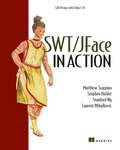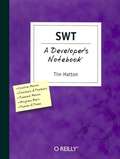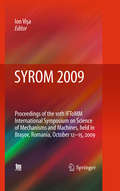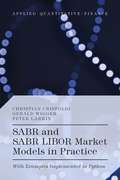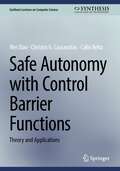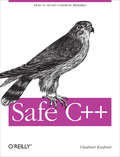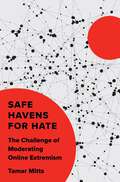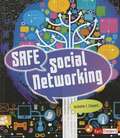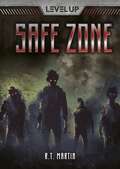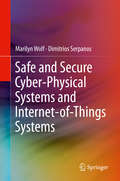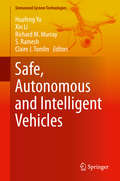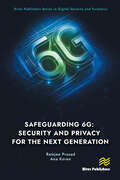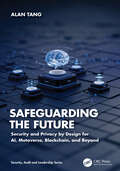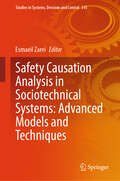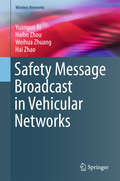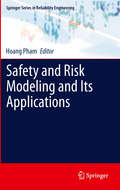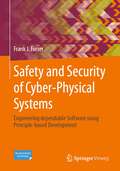- Table View
- List View
SWT/JFace in Action: GUI Design with Eclipse 3.0
by Matthew Scarpino Laurent Mihalkovic Stanford Ng Stephen HolderCovering Eclipse's new capability for building graphical user interfaces with version 3.0, the Standard Widget Toolkit (SWT) and JFace, this guide demonstrates how these award-winning tools have received broad support for creating desktop applications. Theory and practical examples reveal how to build GUIs that combine the look and feel of native interfaces with the platform independence of Java. This guide also shows how SWT makes use of the widgets provided by the operating system and describes how these components can be associated with events, containers, and graphics. With this knowledge, programmers can build fully featured user interfaces that communicate directly with the underlying platform. JFace's ability to simplify and organize the process of GUI design is then demonstrated, enabling developers to modify and adapt components, and separate their information from their appearance.
SWT: A Developer's Notebook
by Tim HattonIn typical Developer's Notebook style, you'll learn how to take SWT out for a spin, make it work for you,and turn it upside down, all without wasted words or space. Each lab in this notebook details a specific task; you can read from the first page to the last, look up just what you need to know, and even squeeze this book into your laptop bag as a quick reference when you forget how to create a multi-tabbed view.
SYROM 2009
by Ion VisaSYROM conferences have been organized since 1973 by the Romanian branch of the International Federation for the Promotion of Mechanisms and Machine Science IFToMM, Year by year the event grew in quality. Now in its 10th edition, international visibility and recognition among the researchers active in the mechanisms science field has been achieved. SYROM 2009 brought together researchers and academic staff from the field of mechanisms and machine science from all over the world and served as a forum for presenting the achievements and most recent results in research and education. Topics treated include conceptual design, kinematics and dynamics, modeling and simulation, synthesis and optimization, command and control, current trends in education in this field, applications in high-tech products. The papers presented at this conference were subjected to a peer-review process to ensure the quality of the paper, the engineering significance, the soundness of results and the originality of the paper. The accepted papers fulfill these criteria and make the proceedings unique among the publications of this type.
Sabr and Sabr LIBOR Market Models in Practice: With Examples Implemented in Python (Applied Quantitative Finance)
by Peter Larkin Christian Crispoldi GéraldwiggerSabr and Sabr LIBOR Market Models in Practice.
Sachkunde im Bewachungsgewerbe (IHK) - Übungsbuch: 250 Fragen mit Antworten und 10 Übungsfälle mit Lösungen
by Robert SchwarzDieses Übungsbuch ergänzt das gleichnamige Lehrbuch. Es schließt die Lücke zwischen dem Unterrichts- und Lernstoff und der Vorbereitung auf die Prüfung. Mit Hilfe der Fragen und Antworten können Lernende den wichtigen Prüfungsstoff strukturiert wiederholen, den eigenen Lernfortschritt kontrollieren und sich gründlich auf die Prüfung vorbereiten. Zehn Übungsfälle mit ausführlichen Lösungen stellen Zusammenhänge her und vertiefen das Gelernte. Die aktualisierte 3. Auflage wurde gründlich durchgesehen.
Sachkunde im Bewachungsgewerbe (IHK) - Übungsbuch: 250 Fragen mit Antworten und 10 Übungsfälle mit Lösungen
by Robert SchwarzDieses Übungsbuch ergänzt das gleichnamige Lehrbuch. Es schließt die Lücke zwischen dem Unterrichts- und Lernstoff und der Vorbereitung auf die Prüfung. Mit Hilfe der Fragen und Antworten können Lernende den wichtigen Prüfungsstoff strukturiert wiederholen, den eigenen Lernfortschritt kontrollieren und sich gründlich auf die Prüfung vorbereiten. Zehn Übungsfälle mit ausführlichen Lösungen stellen Zusammenhänge her und vertiefen das Gelernte. Die aktuelle 4. Auflage wurde sorgfältig durchgesehen.
Sachkunde im Bewachungsgewerbe (IHK) - Übungsbuch: 250 Fragen mit Antworten und 10 Übungsfälle mit Lösungen
by Robert SchwarzDieses Übungsbuch ergänzt das gleichnamige Lehrbuch. Es schließt die Lücke zwischen dem Unterrichts- und Lernstoff und der Vorbereitung auf die Prüfung. Mit Hilfe der Fragen und Antworten können Lernende den wichtigen Prüfungsstoff strukturiert wiederholen, den eigenen Lernfortschritt kontrollieren und sich gründlich auf die Prüfung vorbereiten. Zehn Übungsfälle mit ausführlichen Lösungen stellen Zusammenhänge her und vertiefen das Gelernte. Die überarbeitete 5. Auflage entspricht dem aktuellen Rahmenstoffplan vom Mai 2021.
Sachkunde im Bewachungsgewerbe (IHK): Lehrbuch für Prüfung und Praxis
by Robert SchwarzDieses Lehrbuch behandelt systematisch alle Fachgebiete der IHK-Sachkundeprüfung nach dem aktuellen Rahmenstoffplan. Besonderen Wert hat der Autor dabei auf den oft als schwierig empfundenen Rechtsteil gelegt: Zahlreiche Abbildungen und Beispiele veranschaulichen die Gesetzestexte und ihre Bedeutung für die Praxis, erleichtern das Stoffverständnis und das Lernen. Übersichtlich und verständlich erläutert das Buch die Grundprinzipien der Rechtsordnung der Bundesrepublik Deutschland und deren Anwendung, wichtige Fachbegriffe und die Stellung der privaten Sicherheit. So bietet das Werk die optimale Prüfungsvorbereitung - Schritt für Schritt. Die korrigierte und aktualisierte 4. Auflage wurde dem aktuellen Rahmenstoffplan im Frühjahr 2020 angepasst, insbesondere bezüglich der Verordnung über das Bewachungsgewerbe (BewachV).
Sachkunde im Bewachungsgewerbe (IHK): Lehrbuch für Prüfung und Praxis
by Robert SchwarzDieses Lehrbuch behandelt systematisch alle Fachgebiete der IHK-Sachkundeprüfung nach dem aktuellen Rahmenstoffplan. Besonderen Wert hat der Autor dabei auf den oft als schwierig empfundenen Rechtsteil gelegt: Zahlreiche Abbildungen und Beispiele veranschaulichen die Gesetzestexte und ihre Bedeutung für die Praxis, erleichtern das Stoffverständnis und das Lernen. Übersichtlich und verständlich erläutert das Buch die Grundprinzipien der Rechtsordnung der Bundesrepublik Deutschland und deren Anwendung, wichtige Fachbegriffe und die Stellung der privaten Sicherheit. So bietet das Werk die optimale Prüfungsvorbereitung – Schritt für Schritt. Die gründlich durchgesehene und verbesserte 5. Auflage entspricht dem aktuellen Rahmenstoffplan 2020/2021 und berücksichtigt auch die Verordnung über das Bewachungsgewerbe (BewachV).
Sachkunde im Bewachungsgewerbe (IHK): Lehrbuch für Prüfung und Praxis
by Robert SchwarzDieses Lehrbuch behandelt systematisch alle Fachgebiete der IHK-Sachkundeprüfung nach dem aktuellen Rahmenstoffplan. Besonderen Wert hat der Autor dabei auf den oft als schwierig empfundenen Rechtsteil gelegt: Zahlreiche Abbildungen und Beispiele veranschaulichen die Gesetzestexte und ihre Bedeutung für die Praxis, erleichtern das Stoffverständnis und das Lernen. Übersichtlich und verständlich erläutert das Buch die Grundprinzipien der Rechtsordnung der Bundesrepublik Deutschland und deren Anwendung, wichtige Fachbegriffe und die Stellung der privaten Sicherheit. So bietet das Werk die optimale Prüfungsvorbereitung – Schritt für Schritt. Die überarbdeitete 6. Auflage entspricht dem aktuellen Rahmenstoffplan der DIHK vom Mai 2021.
Safe Autonomy with Control Barrier Functions: Theory and Applications (Synthesis Lectures on Computer Science)
by Wei Xiao Calin Belta Christos G. CassandrasThis book presents the concept of Control Barrier Function (CBF), which captures the evolution of safety requirements during the execution of a system and can be used to enforce safety. Safety is formalized using an emerging state-of-the-art approach based on CBFs, and many illustrative examples from autonomous driving, traffic control, and robot control are provided. Safety is central to autonomous systems since they are intended to operate with minimal or no human supervision, and a single failure could result in catastrophic results. The authors discuss how safety can be guaranteed via both theoretical and application perspectives. This presented method is computationally efficient and can be easily implemented in real-time systems that require high-frequency reactive control. In addition, the CBF approach can easily deal with nonlinear models and complex constraints used in a wide spectrum of applications, including autonomous driving, robotics, and traffic control. With the proliferation of autonomous systems, such as self-driving cars, mobile robots, and unmanned air vehicles, safety plays a crucial role in ensuring their widespread adoption. This book considers the integration of safety guarantees into the operation of such systems including typical safety requirements that involve collision avoidance, technological system limitations, and bounds on real-time executions. Adaptive approaches for safety are also proposed for time-varying execution bounds and noisy dynamics.
Safe C++: How to avoid common mistakes
by Vladimir KushnirIt’s easy to make lots of programming mistakes in C++—in fact, any program over a few hundred lines is likely to contain bugs. With this book, you’ll learn about many common coding errors that C++ programmers produce, along with rules and strategies you can use to avoid them.Author Vladimir Kushnir shows you how to use his Safe C++ library, based in part on programming practices developed by the C++ community. You’ll not only find recipes for identifying errors during your program’s compilation, runtime, and testing phases, you’ll learn a comprehensive approach for making your C++ code safe and bug-free.Get recipes for handling ten different error types, including memory leaks and uninitialized variablesDiscover problems C++ inherited from C, like pointer arithmeticInsert temporary and permanent sanity checks to catch errors at runtimeApply bug prevention techniques, such as using separate classes for each data typePursue a testing strategy to hunt and fix one bug at a time—before your code goes into production
Safe Havens for Hate: The Challenge of Moderating Online Extremism
by Tamar MittsWhy efforts to moderate harmful content on social media fail to stop extremistsContent moderation on social media has become one of the most daunting challenges of our time. Nowhere is the need for action more urgent than in the fight against terrorism and extremism. Yet despite mass content takedowns, account suspensions, and mounting pressure on technology companies to do more, hate thrives online. Safe Havens for Hate looks at how content moderation shapes the tactics of harmful content producers on a wide range of social media platforms.Drawing on a wealth of original data on more than a hundred militant and hate organizations around the world, Tamar Mitts shows how differing moderation standards across platforms create safe havens that allow these actors to organize, launch campaigns, and mobilize supporters. She reveals how the structure of the information environment shapes the cross-platform activity of extremist organizations and movements such as the Islamic State, the Proud Boys, the Oath Keepers, and QAnon, and highlights the need to consider the online ecosystem, not just individual platforms, when developing strategies to combat extremism.Taking readers to the frontlines of the digital battleground where dangerous organizations operate, Safe Havens for Hate sheds critical light on how governments and technology companies grapple with the tension between censorship and free speech when faced with violence, hate, and extremism.
Safe Social Networking
by Frank W. Baker Heather E. SchwartzDescribes safe social networking usage and ways to avoid dangerous situations, such as identity theft, cyberbullying, or predators.
Safe Trajectory Planning for Maritime Surface Ships (Springer Series on Naval Architecture, Marine Engineering, Shipbuilding and Shipping #13)
by Agnieszka LazarowskaThis book offers a comprehensive review of collision avoidance techniques and safe trajectory planning for manned and unmanned ships, together with extensive information on how to develop and implement algorithms for applications in real-world settings. It describes the most relevant decision-support systems and guidance systems used in the control of marine craft, giving a special emphasis to autonomous vehicles, but also covering manned ones. Thanks to its good balance of theory and practice, and the inclusion of basic explanations of all essential concepts, this book fills an important gap in the literature of marine navigation, providing not only researchers and practitioners with a timely reference guide to safe trajectory planning, but also supporting students and newcomers to the field.
Safe Zone (Level Up)
by R. T. MartinNo_Idea has actually no idea how he wound up in the middle of a zombie apocalypse. It's not until he meets another player, named N3V3RDIE, that he learns he's been selected to test a virtual reality video game. And if they don't win the game, they'll be stuck inside the virtual world forever. Will No_Idea figure out the gameplay and make it to the game's safe zone in time, or will he end up trapped in a world filled with virtual zombies?
Safe and Secure Cyber-Physical Systems and Internet-of-Things Systems
by Marilyn Wolf Dimitrios SerpanosThis book provides the first comprehensive view of safe and secure CPS and IoT systems. The authors address in a unified manner both safety (physical safety of operating equipment and devices) and computer security (correct and sound information), which are traditionally separate topics, practiced by very different people. Offers readers a unified view of safety and security, from basic concepts through research challenges;Provides a detailed comparison of safety and security methodologies;Describes a comprehensive threat model including attacks, design errors, and faults;Identifies important commonalities and differences in safety and security engineering.
Safe, Autonomous and Intelligent Vehicles (Unmanned System Technologies)
by Xin Li Richard M. Murray Huafeng Yu S. Ramesh Claire J. TomlinThis book covers the start-of-the-art research and development for the emerging area of autonomous and intelligent systems. In particular, the authors emphasize design and validation methodologies to address the grand challenges related to safety. This book offers a holistic view of a broad range of technical aspects (including perception, localization and navigation, motion control, etc.) and application domains (including automobile, aerospace, etc.), presents major challenges and discusses possible solutions.
Safe, Secure, Ethical, Responsible Technologies and Emerging Applications: First EAI International Conference, SAFER-TEA 2023, Yaoundé, Cameroon, October 25-27, 2023, Proceedings (Lecture Notes of the Institute for Computer Sciences, Social Informatics and Telecommunications Engineering #566)
by Franklin Tchakounte Marcellin Atemkeng Rajeswari Pillai RajagopalanThis book constitutes the refereed proceedings of the First EAI International Conference on Safe, Secure, Ethical, Responsible Technologies and Emerging Applications, SAFER-TEA 2023, held in Yaoundé, Cameroon, during October 25-27, 2023. The 24 full papers were carefully reviewed and selected from 75 submissions. They were organized in topical sections as follows: Regulations and Ethics of Artificial Intelligence, Resource-constrained Networks and Cybersecurity, Emerging Artificial Intelligence Applications, Reviews.
Safeguarding 6G: Security and Privacy for the Next Generation (River Publishers Series in Digital Security and Forensics)
by Ramjee Prasad Ana KorenThis book provides a comprehensive overview of security and privacy challenges in 6G networks, addressing the urgent need for advanced security frameworks as the next generation of wireless technology emerges. The rapid advancements in quantum computing, AI, and IoT are transforming the digital landscape, introducing both unprecedented opportunities and significant security threats. From AI-driven cyberattacks to the vulnerabilities of IoT devices, this book explores cutting-edge technologies such as quantum key distribution (QKD), post-quantum cryptography, and AI-enabled security systems.Designed for professionals and researchers, this resource outlines real-world applications of 6G security techniques, offering practical insights into protecting critical infrastructures, autonomous vehicles, smart cities, and more. By emphasizing a proactive approach to cybersecurity and fostering collaboration across industries, academia, and policymakers, the book lays out a roadmap for ensuring the resilience and trustworthiness of 6G networks in the future.
Safeguarding the Future: Security and Privacy by Design for AI, Metaverse, Blockchain, and Beyond (Security, Audit and Leadership Series)
by Alan TangIn the ever-evolving landscape of technology, emerging innovations like artificial intelligence (AI), blockchain, quantum computing, brain–computer interfaces (BCIs), and the Metaverse are transforming industries at an unprecedented rate. However, with these advancements come significant challenges, particularly in the realms of security and privacy. Safeguarding the Future: Security and Privacy by Design for AI, Metaverse, Blockchain, and Beyond by Dr. Alan Tang offers a comprehensive guide to navigating these challenges, providing a holistic framework to secure and protect the privacy of these cutting-edge technologies.What sets this book apart is its unique blend of technical depth and practical application. Dr. Tang leverages his extensive experience in privacy and security to deliver actionable insights that are crucial for organizations looking to stay ahead in this rapidly changing digital era. From aligning business strategies with security and privacy goals to implementing unified frameworks across multiple technologies, this book is an essential resource for executives, security professionals, and anyone involved in the deployment of emerging technologies.Key Features: In-Depth Analysis: Detailed exploration of the security and privacy risks associated with AI, blockchain, quantum computing, BCI, and other emerging technologies Unified Frameworks: A comprehensive, step-by- step guide to creating and operationalizing a unified security and privacy framework adaptable to various technologies Regulatory Alignment: Insights into aligning security and privacy practices with global regulations such as GDPR, CCPA, and ISO standards Case Studies and Real-World Examples: Practical case studies and examples that illustrate how to apply the concepts discussed in real-world scenarios Ethical Considerations: Examination of ethical issues surrounding the deployment of these technologies, with recommendations for addressing them proactively Future-Proofing Strategies: Guidance on preparing for future advancements and ensuring long-term compliance and security Whether you are a chief technology officer, chief privacy officer, data protection officer, or a security professional, this book equips you with the knowledge and tools needed to protect your organization’s data and ensure the secure deployment of emerging technologies. By adopting the principles outlined in this book, you can not only harness the full potential of these innovations but also safeguard the privacy and security of your organization and its stakeholders.
Safety Causation Analysis in Sociotechnical Systems: Advanced Models and Techniques (Studies in Systems, Decision and Control #541)
by Esmaeil ZareiThis book provides a comprehensive view on theories, models, and techniques used to investigate and analyze incidents and safety causalities occurring in sociotechnical systems. Consisted of intricately interconnected components, sociotechnical systems are always prone to incidents. These incidents can ensue with adverse effects on employees and the public, the environment, and company's properties and reputation. Sometimes, a single incident has the potential to terminate the operation of a business forever. As incidents are multi-factorial and not easy to comprehend, they should be investigated systematically in a structured way so as to find their root causes and prevent them from recurring. Consequently, there have been developed many theories, models, and techniques aimed at accomplishing this goal. However, each approach has its own upsides and downsides, and there is no universal one applicable to all cases. Therefore, researchers and practitioners may sometimes find it difficult to select the most appropriate approach for the given case. After introducing theories, models, and techniques pertaining to incident investigation and safety causalities modeling, this book explains each one in details and discusses their pros and cons. The book aims to provide the audience with a step-by-step guidance for performing incident investigation and analysis. At the end of each chapter an example is analyzed by the introduced tool. Finally, the book offers criteria based on which an incident analysis technique can be selected.
Safety Message Broadcast in Vehicular Networks
by Weihua Zhuang Haibo Zhou Yuanguo Bi Hai ZhaoThis book presents the current research on safety message dissemination in vehicular networks, covering medium access control and relay selection for multi-hop safety message broadcast. Along with an overall overview of the architecture, characteristics, and applications of vehicular networks, the authors discuss the challenging issues in the research on performance improvement for safety applications, and provide a comprehensive review of the research literature. A cross layer broadcast protocol is included to support efficient safety message broadcast by jointly considering geographical location, physical-layer channel condition, and moving velocity of vehicles in the highway scenario. To further support multi-hop safety message broadcast in a complex road layout, the authors propose an urban multi-hop broadcast protocol that utilizes a novel forwarding node selection scheme. Additionally, a busy tone based medium access control scheme is designed to provide strict priority to safety applications in vehicle-to-infrastructure communications. This book offers useful insights into protocol design and inspires a new line of thinking in performance improvements for safety applications in vehicular networks. It is a valuable resource for professionals, researchers, or advanced-level students working in vehicular networks or quality of service.
Safety and Risk Modeling and Its Applications
by Hoang PhamSafety and Risk Modeling presents the latest theories and methods of safety and risk with an emphasis on safety and risk in modeling. It covers applications in several areas including transportations and security risk assessments, as well as applications related to current topics in safety and risk. Safety and Risk Modeling is a valuable resource for understanding the latest developments in both qualitative and quantitative methods of safety and risk analysis and their applications in operating environments. Each chapter has been written by active researchers or experienced practitioners to bridge the gap between theory and practice and to trigger new research challenges in safety and risk. Topics include: safety engineering, system maintenance, safety in design, failure analysis, and risk concept and modelling. Postgraduate students, researchers, and practitioners in many fields of engineering, operations research, management, and statistics will find Safety and Risk Modeling a state-of-the-art survey of reliability and quality in design and practice.
Safety and Security of Cyber-Physical Systems: Engineering dependable Software using Principle-based Development
by Frank J. FurrerCyber-physical systems (CPSs) consist of software-controlled computing devices communicating with each other and interacting with the physical world through sensors and actuators.Because most of the functionality of a CPS is implemented in software, the software is of crucial importance for the safety and security of the CPS. This book presents principle-based engineering for the development and operation of dependable software.The knowledge in this book addresses organizations that want to strengthen their methodologies to build safe and secure software for mission-critical cyber-physical systems.The book:• Presents a successful strategy for the management of vulnerabilities, threats, and failures in mission-critical cyber-physical systems;• Offers deep practical insight into principle-based software development (62 principles are introduced and cataloged into five categories: Business & organization, general principles, safety, security, and risk management principles);• Provides direct guidance on architecting and operating dependable cyber-physical systems for software managers and architects.
